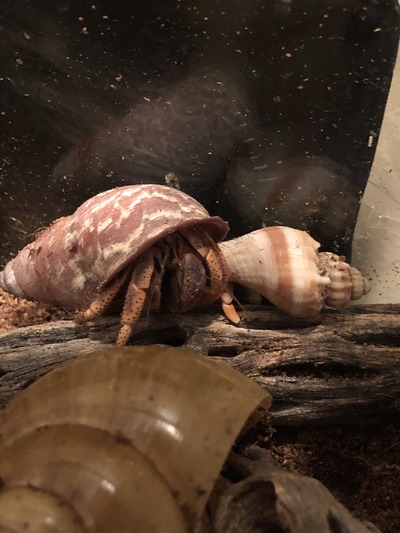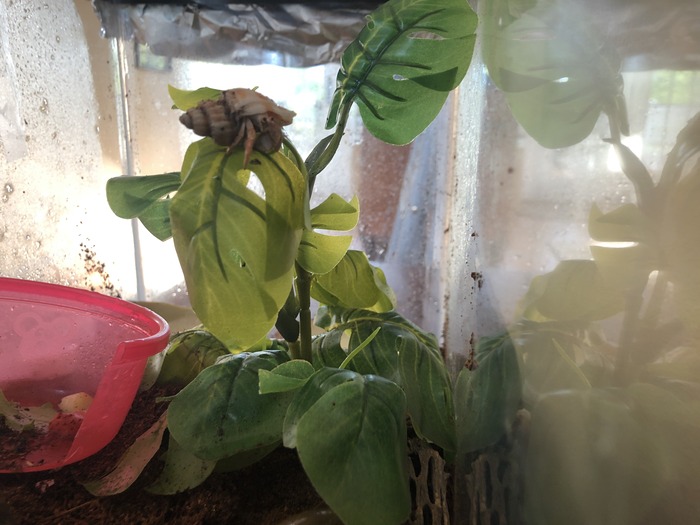it’s easy to look at your hermit crab in its environment and overthink. Why isn’t my crab so active? Why is my crab moving enough? Is it just the demeanor of your hermit crab, or should you be worried? I’m here today to help you understand the normal activity patterns of a healthy hermit crab, and when you should actually worry.
Hermit Crabs are inherently Active, Lazy, or a Mix of both


I’ve had hermit crabs for over 4 years now, and I know the demeanors of each of my crabs. I know Melissa and Hunter (two of my four crabs) are polar opposites. Melissa likes to climb and fall in the water bowl, while Hunter only comes out of his burrow to eat or sit by his heating pad. As long as your hermit crabs have a proper environment and care, you shouldn’t worry about how active or inactive they are.
It’s still natural for you to wonder. So, let’s go over a few reasons why your hermit crab has decided to hide, bury themselves, or just wont move.
Your Hermit Crab is Stressed.
All hermit crabs respond differently to stress. Most crabs burrow or hide in their shell, like they would in the wild in response to danger. If you recently handled your crab or put it through a stressful situation, leave it be and it will return to its normal self once it has calmed down.
Hermit crabs can be stressed by a variety of factors, including changes in temperature, humidity, or water quality; overcrowding or lack of space; inadequate or poor-quality food; and faced with stressful situations such as being held or picked up.
Quick Tip! Hermit crabs thrive in humid environments. If you want your crabs to be more active and you notice their tank is a little dry, use a spray bottle full of water or saltwater to mist the inside of the tank. Your crabs will be very excited and a little more active.
a tip from Taylor
If you just bought your hermit crab, it has a few very good reasons to be unhappy. Pet stores are a stressful place for crabs with people poking and other types of mistreatment.
Also, being moved from the pet store to a completely new place can be unsettling for your little crab. Give the crab a few days before trying to hold it to let it calm down and trust you a bit more.
By then you’ll definitely see the crab scurry around more often. He’ll be unbothered by the fact that you are there and maybe let you hold them.
Let’s say you’ve given your crab some time and it’s still unwilling to show itself. Your crabitat (your crab’s cage) might be to blame.
A good crabitat starts with the container. I recommend a tank instead of a cage to keep the heat and humidity in. You want the cage to stay at a steady 75 to 85 degrees Fahrenheit with 75% relative humidity.
Make sure you have a good substrate. Lining the bottom of your tank with 2-4 inches of firm sand or coconut husk goes a long way. You want something your crabs can burrow in to help when they start molting. The cheap aquarium gravel they sell you at the boardwalk will not cut it.
Your crab needs a source of saltwater and freshwater. I keep mine in 2 small bowls large enough for the crab to hop in with its shell. Use tap water for the freshwater bowl, and aquarium salt for marine fish for the saltwater. Never use salt for human consumption because it can contain harmful minerals.
The last factor could be that your crab has a poor diet. It may not want to come out of its shell because there’s just nothing good to eat.
We didn’t know any better when we first got our crabs and fed them only cereal. While this is a great food for hermit crabs, it’s not enough to give them a healthy, balanced diet.
Once I started throwing a few chopped salad greens and fruit in the mix, I swear I saw a difference. The crabs seemed to almost jump for joy every time I reached in with a new plate of food.
Hermit crabs burrow and stay inactive while they are molting.
It’s normal for hermit crabs to go through periods of being hyper-active and inactive. This usually lines up with their molting cycle, causing crabs to eat, drink, and dig more before they bury themselves to molt. However, this activity can be stifled by an improper habitat and poor care.
There are several signs that a hermit crab is about to molt, including changes in behavior and appearance. Prior to molting, hermit crabs may become less active and spend more time in their shells. They may also stop eating and drinking, and their exoskeletons may appear dull or dry.
During the molting process, hermit crabs are not very active. They remain inside their shells, shedding their old exoskeletons and growing new ones.
his process can take several days or weeks to complete, and during this time, hermit crabs are vulnerable to predators and other threats. After molting, hermit crabs may appear more active and energetic, and their exoskeletons will appear bright and shiny.
Please remember to not bother a hermit crab in any way while they are molting. This is a stressful time for them, and doing so may cause them to die. This is a natural process that all healthy hermit crabs go through.
Hermit crabs are nocturnal.
They should really warn you about this before buying a hermit crab. Hermit crabs are very nocturnal and won’t move around much during the day unless they’re being fed or watered.
If you’re a heavy sleeper like me, sometimes you won’t even notice your crab does all its scurrying around after dark!
There are a few ways to get around this, and sometimes trick your crab into thinking it’s night time.
Keep your crabs in a quiet space (if you have one) that you can pretty easily make dark with curtains or blinds.
I only say “if you have one” because I’m on vacation right now with a family of six. There isn’t a quiet spot in our 900 sqft beach condo. Our hermit crabs stay tucked in their shells all day with us stomping around. Who can blame them? The first thing I’m doing when we get home is finding a quiet spot for the crabs to live stress-free.
Anyway, keep your crabs in a quiet spot that you can easily darken. The crabs might take advantage of the peace and quiet to start scurrying around and do their hermit crab business.
I started this article after everyone went out for a bike ride in the late evening. It’s been a pretty overcast day and I didn’t have the lights on inside.
With the only sound being me quietly tapping away at my keyboard, one of the hermit crabs named Clark came to life.
Instead of cowering in his shell, like he usually does, Clark came alive. He took a stroll across the cage, enjoyed some moisture from his sponge, and scaled one of his climbing toys we bought at the pet store.
Hermit crabs are pretty interesting to watch when they aren’t hiding in their shells!
Hermit crabs are less active when they are alone.
Despite its ironic name and bizarre sleep schedule, the hermit crab is very social and enjoys company. In the wild, hermit crabs live and thrive in large groups or colonies. Whether your crab is from the store or was plucked off the street, it’s probably used to living with plenty of other crabs.
I’ve had a few hermit crabs in my day, and whenever I had more than one crab in a cage they always seemed much more active compared to having just one. I bought two hermit crabs named Betty and Clarke from the store just the other day and they refuse to sit still after dinner when it gets dark.
If you just have one hermit crab, no worries you can always buy another. You should have 5-10 gallons of space for every crab you add to the tank.
Introducing a new crab is usually a harmless process. There might be some wrestling or claw fights, but that’s just the hermit crab’s nature.
Another thing to keep in mind when adding more crabs to the tank is the number of available shells. Each tank should have 2-3 extra shells per crab to give the crab a variety of options when changing shells.
Don’t buy painted shells as they might contain harmful chemicals inside the paint. You want 2-3 shells for each hermit crab with an opening 1/8″ larger or smaller than the hermit crab’s largest claw.
Another way to cure loneliness is toys. Hermit crabs love to climb and duck under obstacles.
Driftwood, dried choya wood, unpainted flower pots, and plastic plants are great features to add to a crabitat. Not only will your hermit crabs have a blast, but they’ll also make your tank look very nice.
Takeaway
Your crab staying in its shell all day isn’t that big of a deal. The crab just isn’t on the same sleep schedule as you. Once your crab becomes more familiar with you it’ll feel more comfortable to come out during the day.
You should be happy your crab decides to stay inside its shell. If you find your crab hanging halfway out of its shell, you might have a problem. This is a clear sign that the crab is beginning to molt or sick.
Related Questions
Why is my hermit crab burrowing itself?
When hermit crabs are beginning to molt, they dig a small cave to protect themselves from predators. They will stay burrowed underground for four to eight weeks while they undergo the stressful molting process.
How do I make my hermit crabs more active?
Try spraying your hermit crabs with a misting bottle filled with lukewarm distilled water. This will increase your crabitat’s humidity, making your crabs more active.
